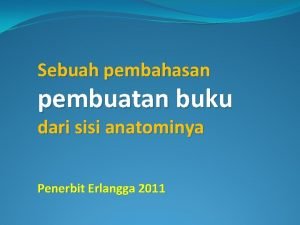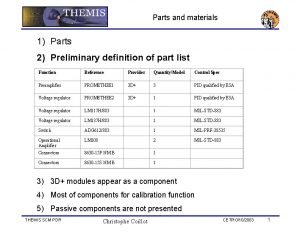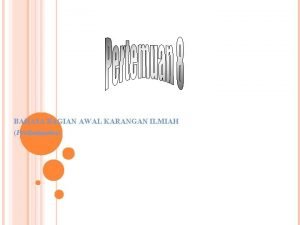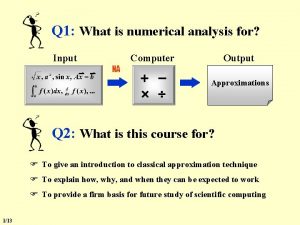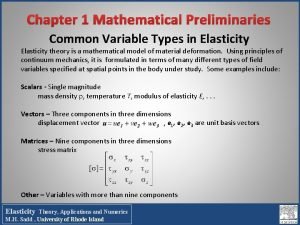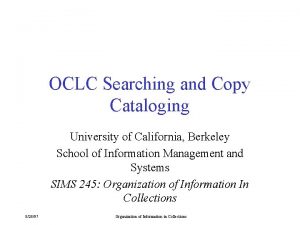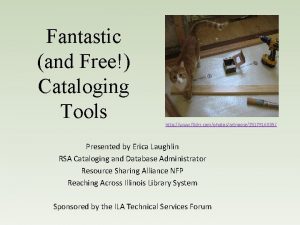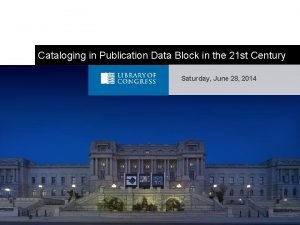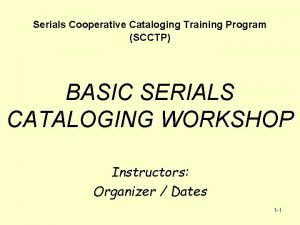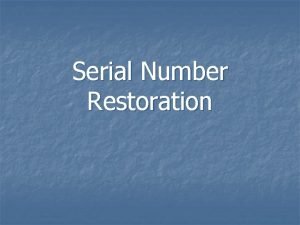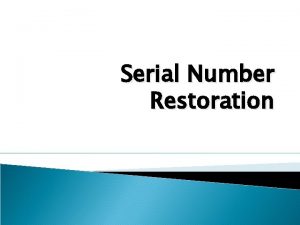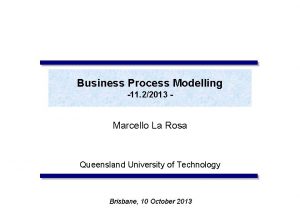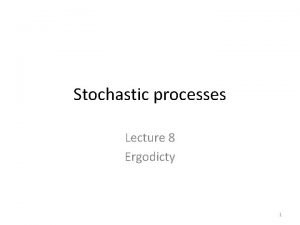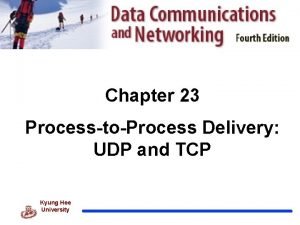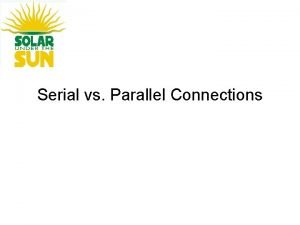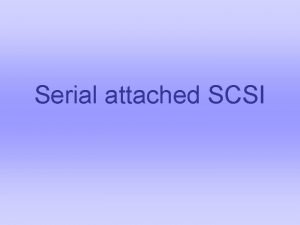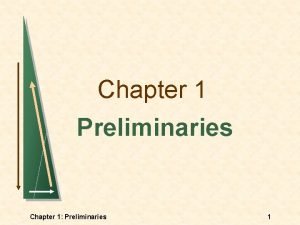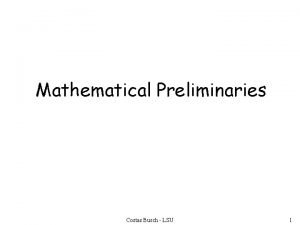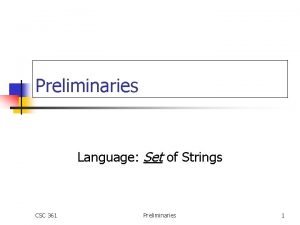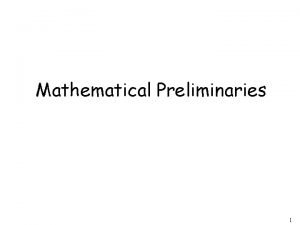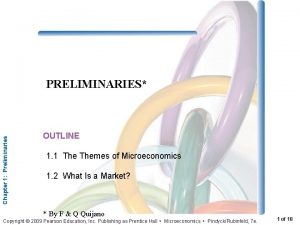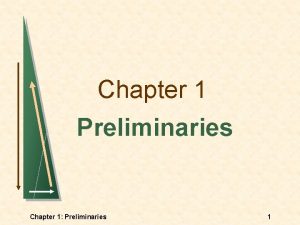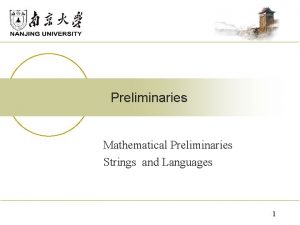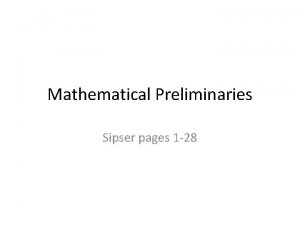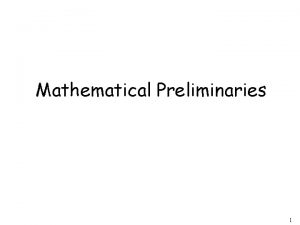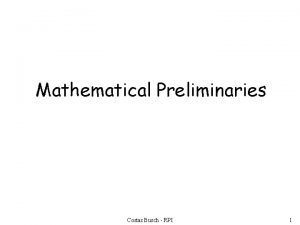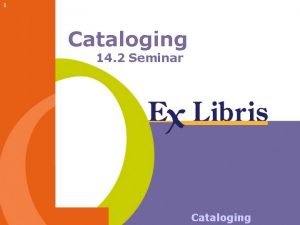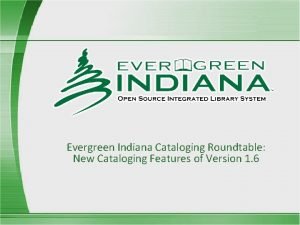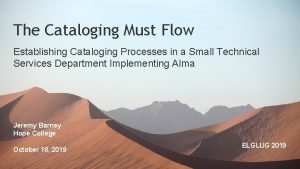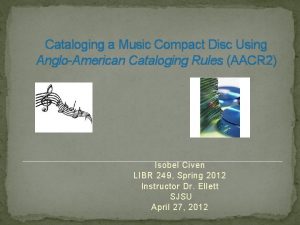3 Cataloging Preliminaries Process of cataloging a serial






















- Slides: 22

3: Cataloging Preliminaries • Process of cataloging a serial – Basis for identification of the resource – Source of information – Identifying manifestation – Transcribing vs. recording data • Core elements for describing a resource – RDA core – CONSER RDA core • CONSER standard record (CSR) 3 -1

Basis for Identification of the Resource General Principles (2. 1) -- Choose a source of information appropriate to the mode of issuance: • single unit see RDA 2. 1. 2. 2 • more than one part see RDA 2. 1. 2. 3 • integrating resource see 2. 1. 2. 4 3 -2

Basis for Identification: Which Issue? RDA 2. 1. 2. 3 Resource Issued in More Than One Part • If the resource has sequentially numbered issues, choose the lowest numbered issue • If the resource has unnumbered issues, choose the earliest date of issue. 3 -3

For example … Have first issue: 362 1# $a Began with: Vol. 1, no. 1 (Jan. 2001). 588 ## $a Description based on: Vol. 1, no. 1 (Jan. 2001); title from cover. 362 1# $a Began with 2007. 588 ## $a Description based on: 2007; title from title page. 3 -4

For example … Earliest available issue (first issue known) : 362 1# $a Began with v. 1, no. 1 (May 2000). 588 ## $a Description based on: Vol. 14, no. 3 (Dec. 2013); title from cover. 362 1# $a Began in Dec. 1998. 588 ## $a Description based on: 2000; title from title page. 3 -5

Preferred Source of Information -Source within the Issue • RDA 2. 2 • Priority order: – Title page, title sheet, or title card – Cover or jacket – Caption – Masthead – Colophon – If none of these source has a title, use another source within the resource that has a title 3 -6

Preferred Source of Information -Sources External to the Issue • RDA 2. 2. 4 • Priority order – Accompanying materials – Other published descriptions of the resource – Container not issued as part of the resource – Any other source (e. g. , a reference source that indicates how the resource is commonly known) 3 -7

RDA Core Elements – What Data to Collect • RDA 0. 6. 1 – “As a minimum, a resource description for a work, expression, manifestation, or item should include all the core elements that are applicable and readily ascertainable. ” – Inclusion of other specific elements is discretionary 3 -8

CONSER Core Elements -What Data to Collect • Follows RDA 0. 6. 1 in its approach to the concept of core • A combination of RDA “Core, ” RDA “Core if, ” “PCC Core, ” and “PCC Recommended” • Should be read in conjunction with the LC-PCC -PSs that are integrated into the RDA Toolkit 3 -9

CONSER Standard Record • A baseline set of elements that emphasize access points over descriptive data • Includes essential data elements necessary to meet user needs • A solid "floor“ description of a resource that can be built upon in a shared environment • Does not preclude the use of any data in a bibliographic description representing more extensive cataloging treatment 3 -10

How Data is entered in a Cataloging Record • Some manifestation elements are transcribed • Other manifestation elements can be recorded with some adjustment • There are many exceptions to transcription instructions for serials (variable data) 3 -11 11

Transcription of Data • “Take What You See” • ICP Principle of Representation • Generally, record what is on the resource – Accurate representation – Encourage re-use of found data 3 -12

Recording Data • Some information may be manipulated when recorded by the cataloger (either when taken from the resource or from another source) • For recorded elements, the found information is often adjusted (for example, use an appropriate term from RDA 2. 14. 1. 3 to record the frequency) 3 -13

What am I Cataloging? • Work • Expression • Manifestation • Item • Primary focus on: CONSER RDA core elements 3 -14 14

Transcribed Manifestation Elements • • Title proper and parallel title proper Other title information Statement of responsibility Edition information Numbering information Place of publisher, distributor, manufacturer Name of publisher, distributor, manufacturer Series information other than ISSN 3 -15 15

Recorded Manifestation Elements Date of publication, distribution, manufacture Copyright date Mode of issuance Frequency Identifier of the manifestation (e. g. , ISSN usually) Key title Notes about element (e. g. , source of title) Issue or part used as basis of description (DBO and LIC) • Notes about changes over time • • 3 -16 16

Preferred Title • The title or form of title chosen to identify the work • Choose the preferred title by applying the instructions at 6. 2. 2. 4– 6. 2. 2. 7 • The basis for the authorized access point representing that work 3 -17

For example … 245 00 $a Look Japan. 245 00 $a Adobe magazine. 245 10 $a Network. 245 10 $a Annual report / $c ICSID. 245 14 $a The country music newsletter. 3 -18

Authorized Access Point for a Work • Standardized access point representing a work • RDA 5. 5 – 2 parts: • Creator of the work • Preferred title for the work 3 -19 19

For example … • A work does not necessarily have a “creator: ” 245 00 $a Look Japan. 245 00 $a Adobe magazine. 130 0# $a Network (Bristol, England) 245 10 $a Network. 130 0# $a Network (Friends of the Earth) 245 10 $a Network. 3 -20

For example … Works with a “creator: ” • corporate body: 110 2# $a International Centre for Settlement of Investment Disputes, $e creator. 245 10 $a Annual report / $c ICSID. • personal author (rare): 100 1# $a Gresham, Don, $e author. 245 14 $a The country music newsletter. 3 -21

Summary • Base the description on the first or earliest available issue in hand • The preferred source is the title page or its substitute (cover, caption, etc. ) • Some manifestation elements are transcribed • Other manifestation elements can be recorded with some adjustment • There are many exceptions to transcription instructions for serials (variable data) • CONSER RDA core elements 3 -22 22
 Apa itu preliminaries
Apa itu preliminaries Parts of preliminaries
Parts of preliminaries Halaman preliminaries
Halaman preliminaries Mathematical preliminaries in numerical computing
Mathematical preliminaries in numerical computing Chapter 1 mathematical preliminaries
Chapter 1 mathematical preliminaries Initiative synoynm
Initiative synoynm Copy cataloging
Copy cataloging Progress report for internship
Progress report for internship Rda cataloging cheat sheet
Rda cataloging cheat sheet Cataloging-in-publication data
Cataloging-in-publication data Conser cataloging manual
Conser cataloging manual 4 bit shift register
4 bit shift register What is soap opera
What is soap opera Typoology
Typoology Organized vs disorganized serial killers
Organized vs disorganized serial killers How to restore serial numbers by acid etching
How to restore serial numbers by acid etching Unique laser etched serial number
Unique laser etched serial number Coronoid process and coracoid process
Coronoid process and coracoid process Substantive vs procedural due process
Substantive vs procedural due process Business process levels
Business process levels Ergodicity
Ergodicity What is process to process delivery
What is process to process delivery Condylar process and coronoid process
Condylar process and coronoid process
